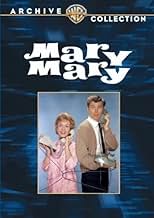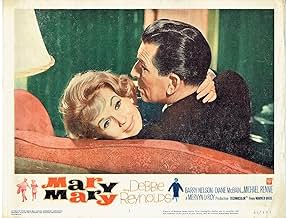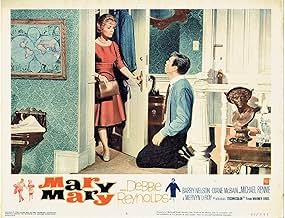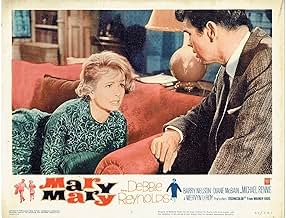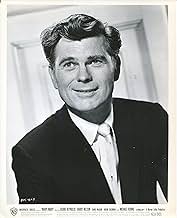Aggiungi una trama nella tua linguaBob and Mary, recently divorced, reunite to settle tax issues. Bob plans to marry Tiffany, while Mary is drawn to Dirk, a Hollywood star. Tensions arise as Bob fears being alone with Mary, r... Leggi tuttoBob and Mary, recently divorced, reunite to settle tax issues. Bob plans to marry Tiffany, while Mary is drawn to Dirk, a Hollywood star. Tensions arise as Bob fears being alone with Mary, reflecting their complicated dynamic after split.Bob and Mary, recently divorced, reunite to settle tax issues. Bob plans to marry Tiffany, while Mary is drawn to Dirk, a Hollywood star. Tensions arise as Bob fears being alone with Mary, reflecting their complicated dynamic after split.
- Cleaning Woman
- (non citato nei titoli originali)
- Woman at Restaurant
- (non citato nei titoli originali)
- Husband in Elevator
- (non citato nei titoli originali)
- Secretary
- (non citato nei titoli originali)
- Old Timer
- (non citato nei titoli originali)
- Wife in Elevator
- (non citato nei titoli originali)
- Doorman
- (non citato nei titoli originali)
- Newscaster
- (voce)
- (non citato nei titoli originali)
- Waiter
- (non citato nei titoli originali)
Recensioni in evidenza
When Warner Brothers gave Mervyn LeRoy the directorial reigns on their Burbank soundstages, Debbie Reynolds was awarded the title role, co-starring with Barry Nelson who had appeared in the stage version. It was always the way, when the studio system still held sway, that the obvious and only choice was a bonafide Hollywood movie star to headline a project such as this, and so the very appealing Barbara Bel Geddes, who had played Mary McKellaway on the stage to excellent notices, was not to repeat her role before the Technicolor cameras. Debbie, as she had in her previous M-G-M starring roles, didn't disappoint, however, and she was ably supported by Mr. Nelson, the gorgeous Diane McBain, and, in a witty turn (and a departure from the usually more serious roles assigned to him), Michael Rennie.
An acquaintance of mine worked in the sound editing department at Warner Brothers when this was being filmed and he confided to me that Ms. Reynolds played an anxious visit to a screening/editing room during filming, somewhat concerned that her performance wouldn't strike just the right comical note. I seem to recall that she was reassured by that technician and his coworkers and the reviewers and the film's audiences were eventually in agreement.
It would have been a much better film if Debbie Reynolds been given better (or any) direction.
Debbie was sometimes not adept at playing it real, there was sometimes a sense that she was making an effort. But at her best, she was spontaneous and delightful - especially in her earlier efforts like Singin' In The Rain, Athena, Give A Girl A Break, I Love Melvin, etc.
Take a look at Debbie in Susan Slept Here (written and directed by Frank Tashlin) if you don't think she could be real, believable, touching, funny, and everything else she is supposed to be here, and isn't. There's a reason she became a bigger star than many of the MGM girls she originally appeared in support of - and guys, for that matter. Even when she isn't too good (as in this film) it's obvious that she has star power. Imagine a film starring the other four leads and no Debbie.
The trouble here is that, rather than relying on her own vocal inflections, and her proved ability to deliver comic dialogue, she gives an imitation of Barbara Bel Geddes (the original star of the Broadway show)! I don't know whose idea this was, but it wasn't a good one.
It's a decent romantic comedy that has a lot of pretty good jokes about the contemporary fads and foibles of the day. The action really doesn't leave the apartment set. The set and costumes are in deliberately neutral tones, like they were designed to be shot in black and white. (The brightest colors are in the title sequence.) Like Debbie's performance, the stylized color scheme serves to distance us from the story, since it encourages us not to forget we're watching something unreal. The whole thing is shot at some distance from the actors - though this seems to have been Mervyn LeRoy's later style, in general. This also hampers involvement.
The performances of Barry Nelson and Michael Rennie - the original Broadway stars - as well as Hiram Sherman, who took over on Broadway from John Cromwell, the actor and director ("Since You Went Away"), are quite good, and Diane MacBain is charming.
That said, there is something impenetrable about watching Debbie Reynolds looking positively gorgeous as she tells Michael Rennie of the trials and tribulations of being a "plain" girl and woman. The part of Mary was written for Barbara Bel Geddes, who fit that dialogue perfectly (see her Midge in "Vertigo"). Debbie, on the other hand, was simply too radiant to give credibility to a character who supposedly compensated for insecurity about her looks with unceasing wit.
Lo sapevi?
- QuizThis is one of the few instances when a movie was released while the Broadway play was still running.
- BlooperWoken by a ringing bell Mary opens the door and lets Tiffany in who crosses the room and opens the curtains revealing that it's daylight . Strong shadows point in all directions as being from studio lights.
- Citazioni
Bob McKellaway: [lovingly] I married Mary because she was so direct, and straightforward, and said exactly what she meant.
Oscar Nelson: Why did you divorce her?
Bob McKellaway: [sternly] Because she was so direct, and straightforward, and said exactly what she meant.
- ConnessioniReferenced in To Tell the Truth: Tom Poston, Betty White, Barry Nelson, Kitty Carlisle (1962)
I più visti
- How long is Mary, Mary?Powered by Alexa
Dettagli
- Data di uscita
- Paese di origine
- Lingua
- Celebre anche come
- Mary, Mary
- Luoghi delle riprese
- Aziende produttrici
- Vedi altri crediti dell’azienda su IMDbPro
- Tempo di esecuzione2 ore 6 minuti
- Proporzioni
- 1.66 : 1


